YAMAHA NMAX 150 2017 User Guide
Manufacturer: YAMAHA, Model Year: 2017, Model line: NMAX 150, Model: YAMAHA NMAX 150 2017Pages: 94, PDF Size: 3.7 MB
Page 11 of 94

Safety information
1-5
1
Aftermarket Tires an
d Rims
The tires and rims that came with your
scooter were designed to match the
performance capabilities and to pro-
vide the best combination of handling,
braking, and comfort. Other tires, rims,
sizes, and combinations may not be
appropriate. Refer to page 6-20 for tire
specifications and more information on
replacing your tires.
Transportin g the Scooter
Be sure to observe following instruc-
tions before transporting the scooter in
another vehicle. Remove all loose items from the
scooter.
Point the front wheel straight
ahead on the trailer or in the truck
bed, and choke it in a rail to pre-
vent movement.
Secure the scooter with tie-downs
or suitable straps that are at-
tached to solid parts of the scoot-
er, such as the frame or upper
front fork triple clamp (and not, for
example, to rubber-mounted han-
dlebars or turn signals, or parts
that could break). Choose the lo-
cation for the straps carefully so
the straps will not rub against
painted surfaces during transport.
The suspension should be com-
pressed somewhat by the tie-
downs, if possible, so that the
scooter will not bounce exces-
sively during transport.
EAU57600
Further safe-ri din g points
Be sure to signal clearly when
making turns.
Braking can be extremely difficult
on a wet road. Avoid hard braking,
because the scooter could slide.
Apply the brakes slowly when
stopping on a wet surface.
Slow down as you approach a
corner or turn. Once you have
completed a turn, accelerate
slowly.
Be careful when passing parked
cars. A driver might not see you
and open a door in your path.
Railroad crossings, streetcar rails,
iron plates on road construction
sites, and manhole covers be-
come extremely slippery when
wet. Slow down and cross them
with caution. Keep the scooter up-
right, otherwise it could slide out
from under you.
The brake pads or linings could
get wet when you wash the scoot-
er. After washing the scooter,
check the brakes before riding.
Always wear a helmet, gloves,
trousers (tapered around the cuff
and ankle so they do not flap), and
a brightly colored jacket.
Do not carry too much luggage on
the scooter. An overloaded scoot-
er is unstable. Use a strong cord
to secure any luggage to the carri-
er (if equipped). A loose load will
affect the stability of the scooter
and could divert your attention
from the road. (See page 1-3.)
UBV3E0E0.book Page 5 Monday, September 26, 2016 3:42 PM
Page 12 of 94
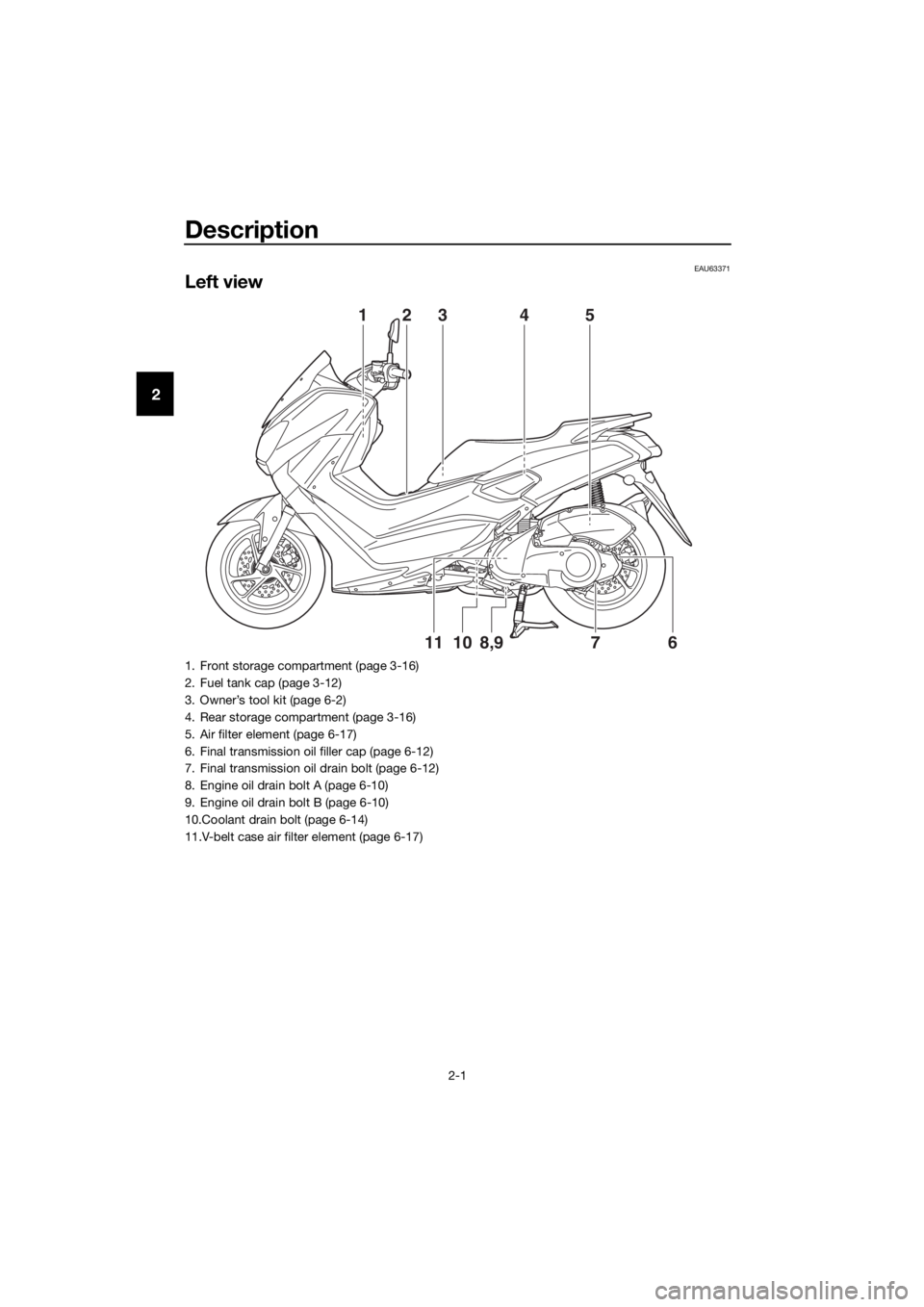
Description
2-1
2
EAU63371
Left view
678,91011
123 4 5
1. Front storage compartment (page 3-16)
2. Fuel tank cap (page 3-12)
3. Owner’s tool kit (page 6-2)
4. Rear storage compartment (page 3-16)
5. Air filter element (page 6-17)
6. Final transmission oil filler cap (page 6-12)
7. Final transmission oil drain bolt (page 6-12)
8. Engine oil drain bolt A (page 6-10)
9. Engine oil drain bolt B (page 6-10)
10.Coolant drain bolt (page 6-14)
11.V-belt case air filter element (page 6-17)
UBV3E0E0.book Page 1 Monday, September 26, 2016 3:42 PM
Page 13 of 94
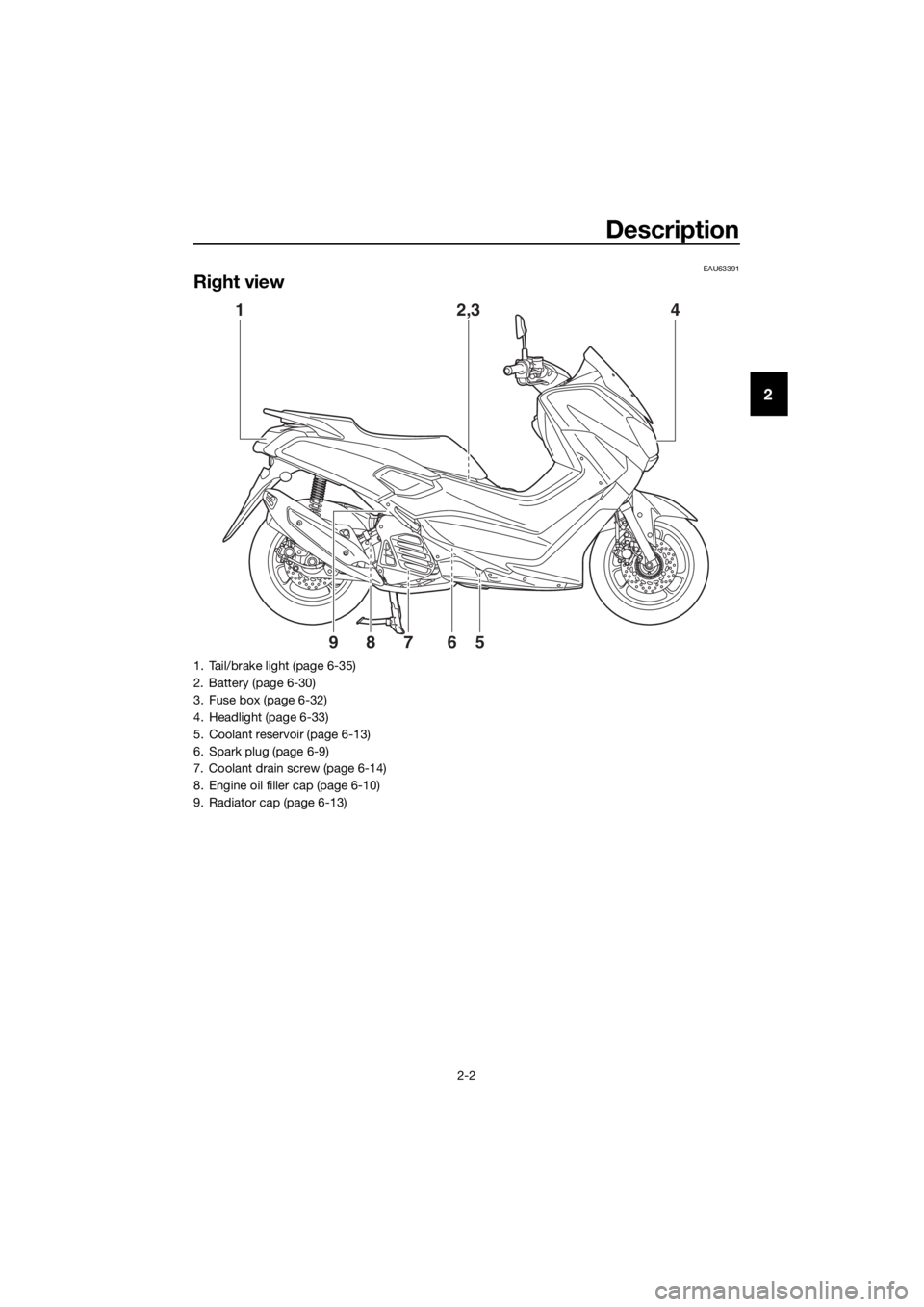
Description
2-2
2
EAU63391
Right view
1 2,34
567
89
1. Tail/brake light (page 6-35)
2. Battery (page 6-30)
3. Fuse box (page 6-32)
4. Headlight (page 6-33)
5. Coolant reservoir (page 6-13)
6. Spark plug (page 6-9)
7. Coolant drain screw (page 6-14)
8. Engine oil filler cap (page 6-10)
9. Radiator cap (page 6-13)
UBV3E0E0.book Page 2 Monday, September 26, 2016 3:42 PM
Page 14 of 94
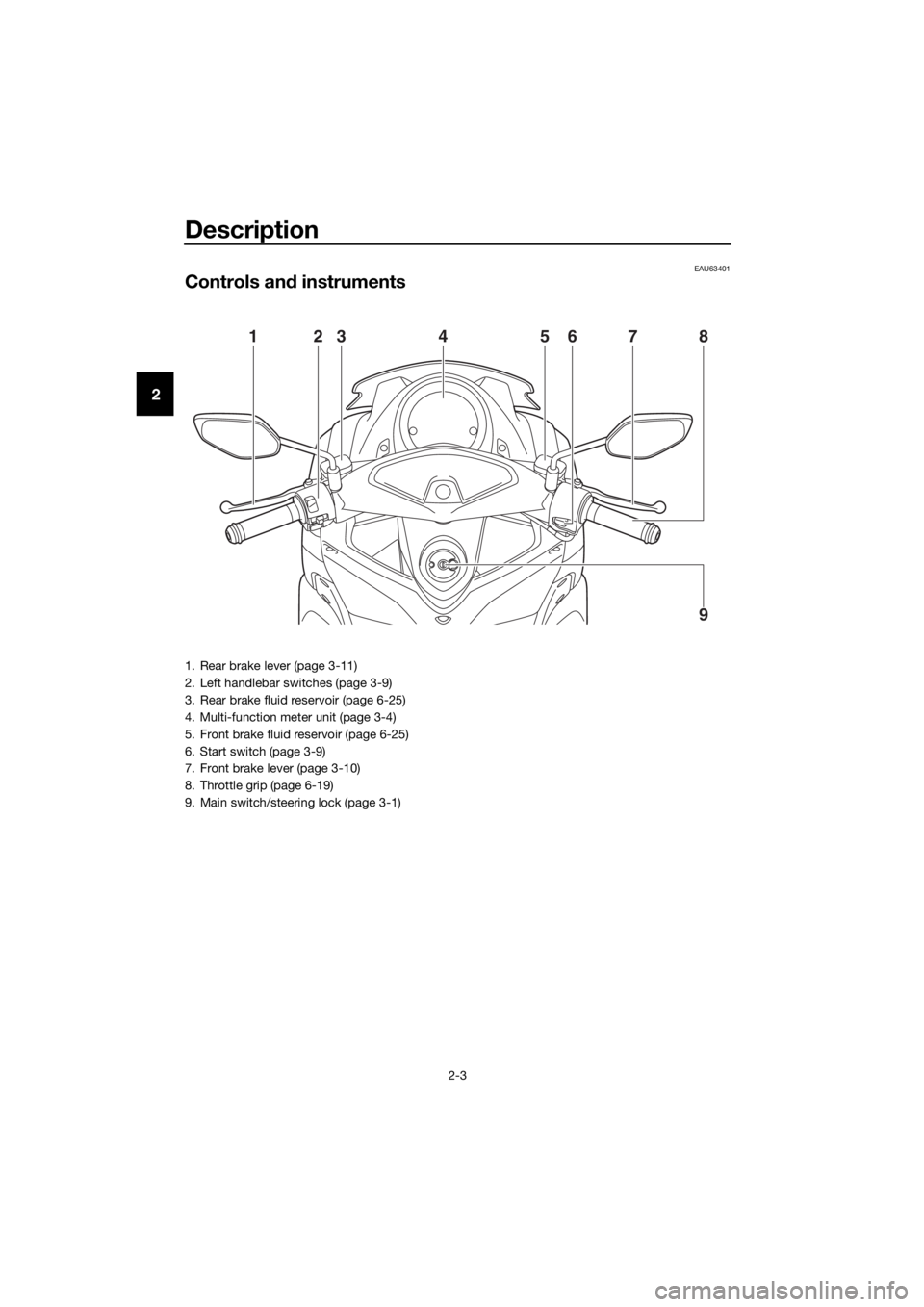
Description
2-3
2
EAU63401
Controls and instruments
12376854
9
1. Rear brake lever (page 3-11)
2. Left handlebar switches (page 3-9)
3. Rear brake fluid reservoir (page 6-25)
4. Multi-function meter unit (page 3-4)
5. Front brake fluid reservoir (page 6-25)
6. Start switch (page 3-9)
7. Front brake lever (page 3-10)
8. Throttle grip (page 6-19)
9. Main switch/steering lock (page 3-1)
UBV3E0E0.book Page 3 Monday, September 26, 2016 3:42 PM
Page 15 of 94
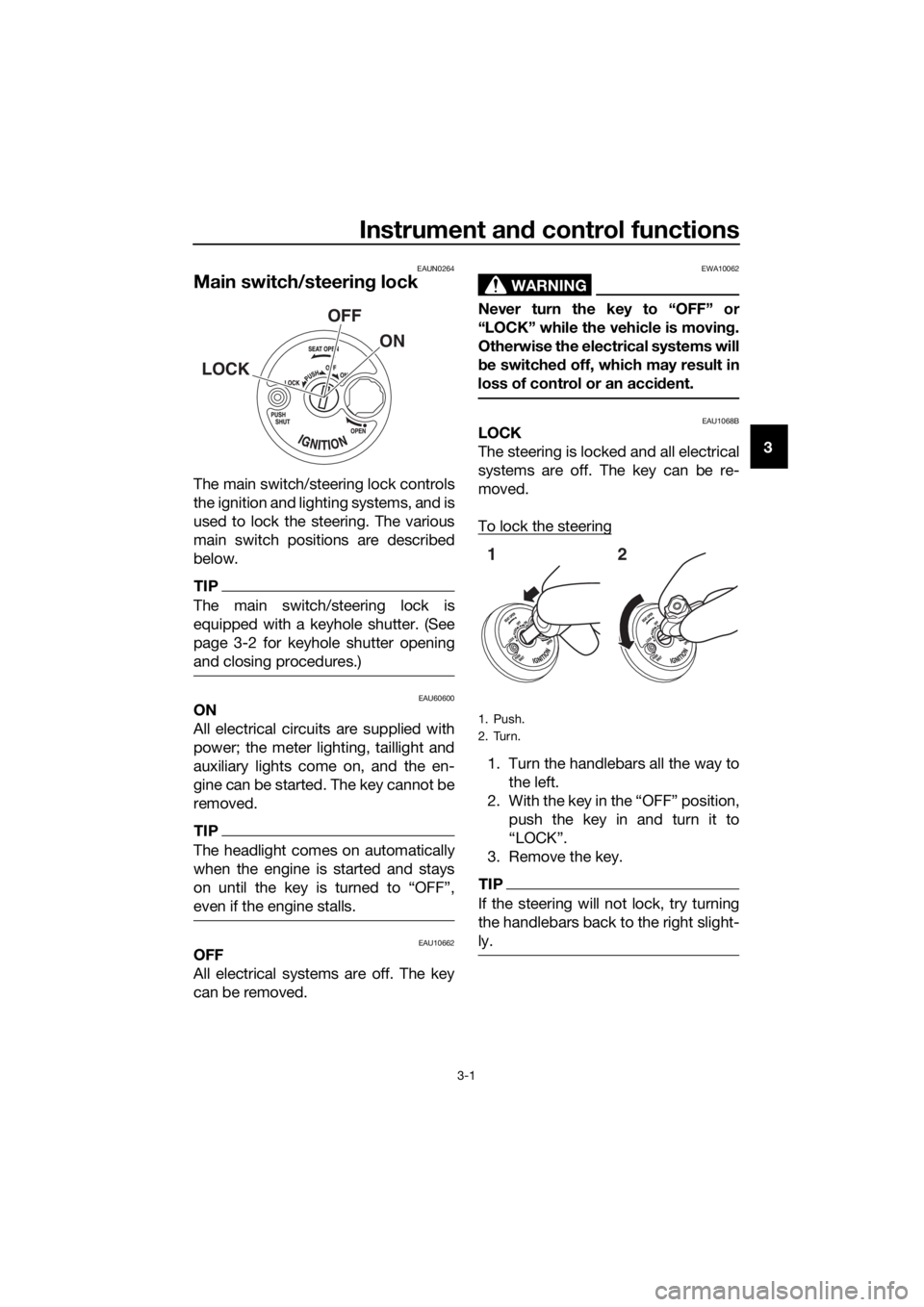
Instrument and control functions
3-1
3
EAUN0264
Main switch/steerin g lock
The main switch/steering lock controls
the ignition and lighting systems, and is
used to lock the steering. The various
main switch positions are described
below.
TIP
The main switch/steering lock is
equipped with a keyhole shutter. (See
page 3-2 for keyhole shutter opening
and closing procedures.)
EAU60600ON
All electrical circuits are supplied with
power; the meter lighting, taillight and
auxiliary lights come on, and the en-
gine can be started. The key cannot be
removed.
TIP
The headlight comes on automatically
when the engine is started and stays
on until the key is turned to “OFF”,
even if the engine stalls.
EAU10662OFF
All electrical systems are off. The key
can be removed.
WARNING
EWA10062
Never turn the key to “OFF” or
“LOCK” while the vehicle is movin g.
Otherwise the electrical systems will
b e switche d off, which may result in
loss of control or an acci dent.
EAU1068BLOCK
The steering is locked and all electrical
systems are off. The key can be re-
moved.
To lock the steering
1. Turn the handlebars all the way to
the left.
2. With the key in the “OFF” position, push the key in and turn it to
“LOCK”.
3. Remove the key.
TIP
If the steering will not lock, try turning
the handlebars back to the right slight-
ly.
ON
OFF
LOCK
1. Push.
2. Turn.
12
UBV3E0E0.book Page 1 Monday, September 26, 2016 3:42 PM
Page 16 of 94

Instrument and control functions
3-2
3 To unlock the steering
From the “LOCK” position, push the
key in and turn it to “OFF”.
EAUN0353
Keyhole shutter
To open the keyhole shutter
Insert the key head into the keyhole
shutter receptacle as shown, and then
turn the key to the right to open the
keyhole shutter.
To close the keyhole shutter
Press the “PUSH SHUT” button to
close the keyhole shutter.
1. Push.
2. Turn.
12
1. “PUSH SHUT” button
2. Key head
12
UBV3E0E0.book Page 2 Monday, September 26, 2016 3:42 PM
Page 17 of 94
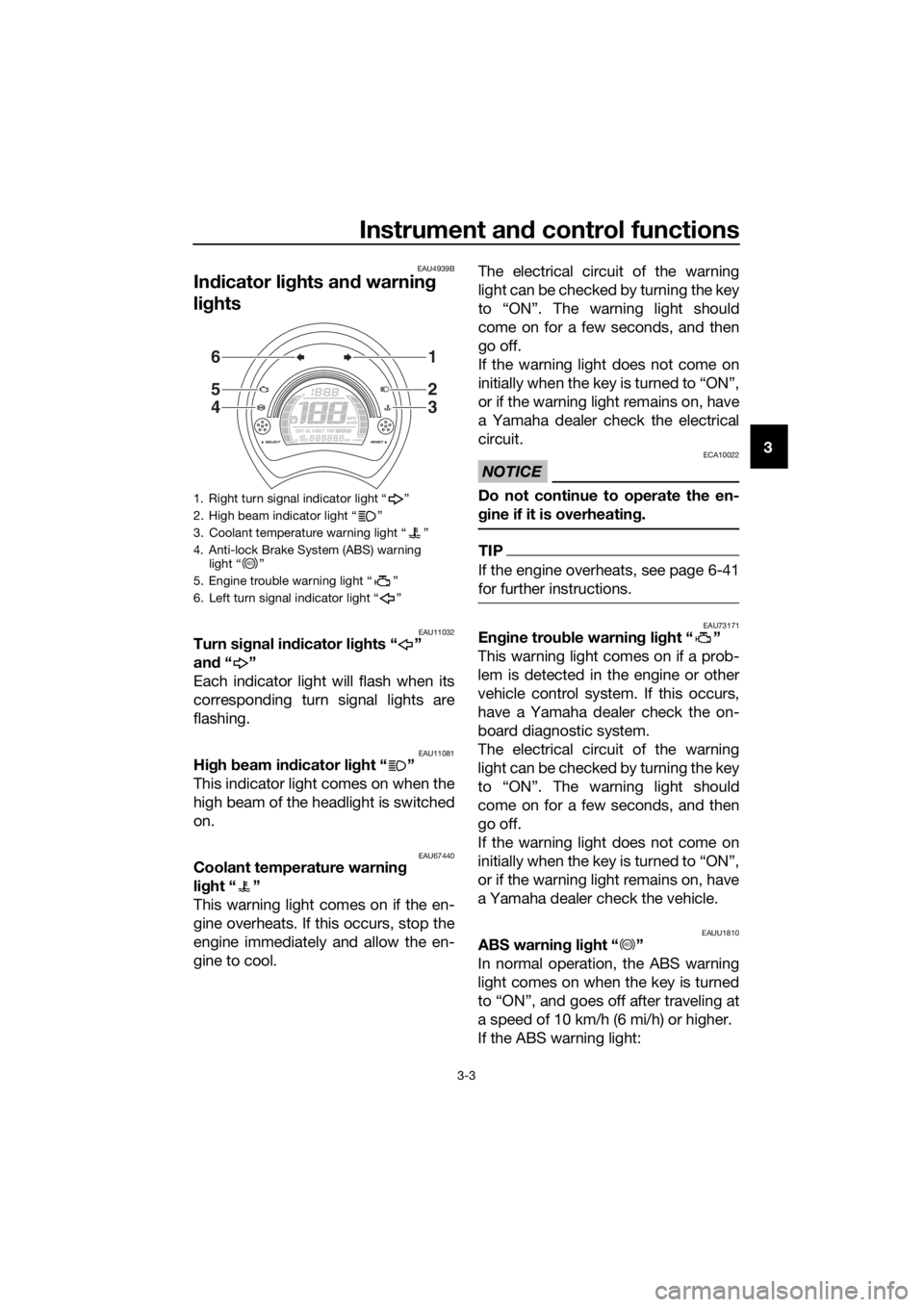
Instrument and control functions
3-3
3
EAU4939B
In dicator li ghts an d warnin g
li g hts
EAU11032Turn si gnal in dicator li ghts “ ”
an d“”
Each indicator light will flash when its
corresponding turn signal lights are
flashing.
EAU11081Hi gh beam in dicator li ght “ ”
This indicator light comes on when the
high beam of the headlight is switched
on.
EAU67440Coolant temperature warnin g
li g ht “ ”
This warning light comes on if the en-
gine overheats. If this occurs, stop the
engine immediately and allow the en-
gine to cool. The electrical circuit of the warning
light can be checked by turning the key
to “ON”. The warning light should
come on for a few seconds, and then
go off.
If the warning light does not come on
initially when the key is turned to “ON”,
or if the warning light remains on, have
a Yamaha dealer check the electrical
circuit.
NOTICE
ECA10022
Do not continue to operate the en-
g
ine if it is overheatin g.
TIP
If the engine overheats, see page 6-41
for further instructions.
EAU73171En gine trou ble warnin g li ght “ ”
This warning light comes on if a prob-
lem is detected in the engine or other
vehicle control system. If this occurs,
have a Yamaha dealer check the on-
board diagnostic system.
The electrical circuit of the warning
light can be checked by turning the key
to “ON”. The warning light should
come on for a few seconds, and then
go off.
If the warning light does not come on
initially when the key is turned to “ON”,
or if the warning light remains on, have
a Yamaha dealer check the vehicle.
EAUU1810ABS warnin g lig ht “ ”
In normal operation, the ABS warning
light comes on when the key is turned
to “ON”, and goes off after traveling at
a speed of 10 km/h (6 mi/h) or higher.
If the ABS warning light:
1. Right turn signal indicator light “ ”
2. High beam indicator light “ ”
3. Coolant temperature warning light “ ”
4. Anti-lock Brake System (ABS) warning light “ ”
5. Engine trouble warning light “ ”
6. Left turn signal indicator light “ ”
6
5
4
1
2
3
ABS
ABS
UBV3E0E0.book Page 3 Monday, September 26, 2016 3:42 PM
Page 18 of 94
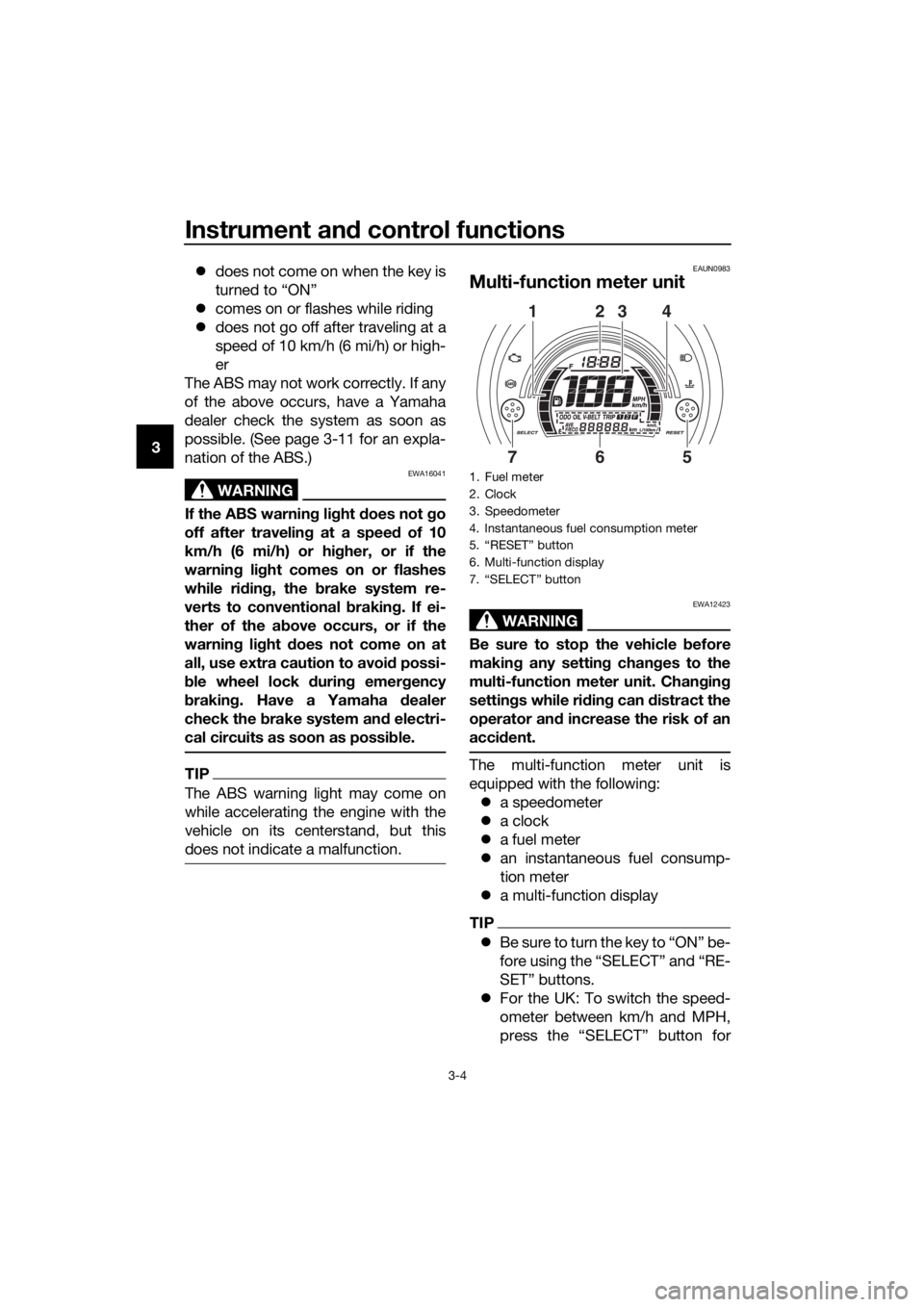
Instrument and control functions
3-4
3
does not come on when the key is
turned to “ON”
comes on or flashes while riding
does not go off after traveling at a
speed of 10 km/h (6 mi/h) or high-
er
The ABS may not work correctly. If any
of the above occurs, have a Yamaha
dealer check the system as soon as
possible. (See page 3-11 for an expla-
nation of the ABS.)
WARNING
EWA16041
If the ABS warnin g li ght does not go
off after travelin g at a speed of 10
km/h (6 mi/h) or hi gher, or if the
warnin g li ght comes on or flashes
while ri din g, the brake system re-
verts to conventional brakin g. If ei-
ther of the a bove occurs, or if the
warnin g li ght does not come on at
all, use extra caution to avoi d possi-
b le wheel lock during emer gency
b rakin g. Have a Yamaha dealer
check the brake system an d electri-
cal circuits as soon as possi ble.
TIP
The ABS warning light may come on
while accelerating the engine with the
vehicle on its centerstand, but this
does not indicate a malfunction.
EAUN0983
Multi-function meter unit
WARNING
EWA12423
Be sure to stop the vehicle before
makin g any settin g chan ges to the
multi-function meter unit. Chang ing
settin gs while ri din g can d istract the
operator an d increase the risk of an
acci dent.
The multi-function meter unit is
equipped with the following:
a speedometer
a clock
a fuel meter
an instantaneous fuel consump-
tion meter
a multi-function display
TIP
B e s u r e t o t u r n t h e k e y t o “ O N ” b e -
fore using the “SELECT” and “RE-
SET” buttons.
For the UK: To switch the speed-
ometer between km/h and MPH,
press the “SELECT” button for
1. Fuel meter
2. Clock
3. Speedometer
4. Instantaneous fuel consumption meter
5. “RESET” button
6. Multi-function display
7. “SELECT” button
2314
675
UBV3E0E0.book Page 4 Monday, September 26, 2016 3:42 PM
Page 19 of 94
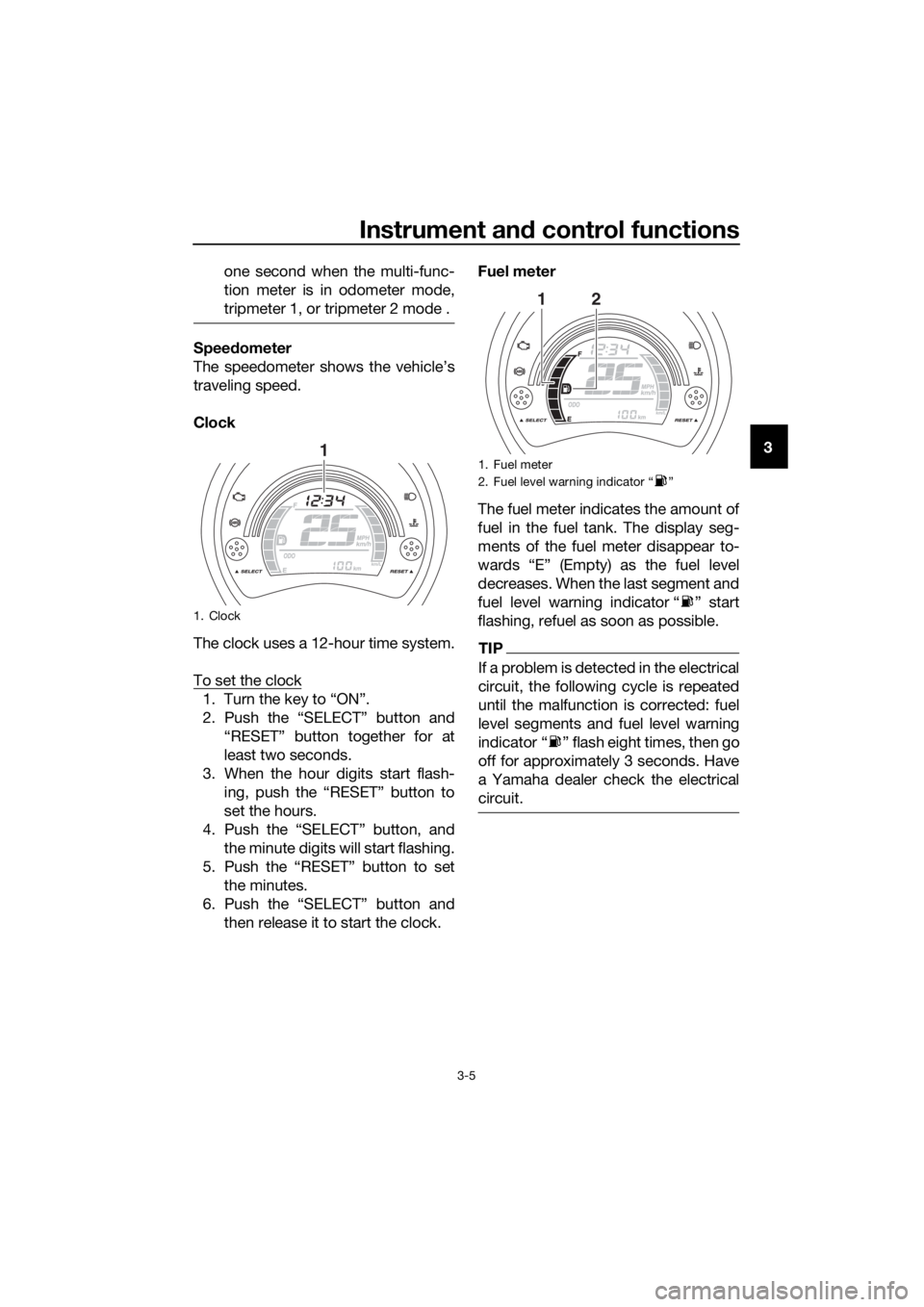
Instrument and control functions
3-5
3
one second when the multi-func-
tion meter is in odometer mode,
tripmeter 1, or tripmeter 2 mode .
Speed
ometer
The speedometer shows the vehicle’s
traveling speed.
Clock
The clock uses a 12-hour time system.
To set the clock
1. Turn the key to “ON”.
2. Push the “SELECT” button and “RESET” button together for at
least two seconds.
3. When the hour digits start flash- ing, push the “RESET” button to
set the hours.
4. Push the “SELECT” button, and
the minute digits will start flashing.
5. Push the “RESET” button to set the minutes.
6. Push the “SELECT” button and then release it to start the clock. Fuel meter
The fuel meter indicates the amount of
fuel in the fuel tank. The display seg-
ments of the fuel meter disappear to-
wards “E” (Empty) as the fuel level
decreases. When the last segment and
fuel level warning indicator “ ” start
flashing, refuel as soon as possible.
TIP
If a problem is detected in the electrical
circuit, the following cycle is repeated
until the malfunction is corrected: fuel
level segments and fuel level warning
indicator “ ” flash eight times, then go
off for approximately 3 seconds. Have
a Yamaha dealer check the electrical
circuit.
1. Clock
11. Fuel meter
2. Fuel level warning indicator “ ”
12
UBV3E0E0.book Page 5 Monday, September 26, 2016 3:42 PM
Page 20 of 94
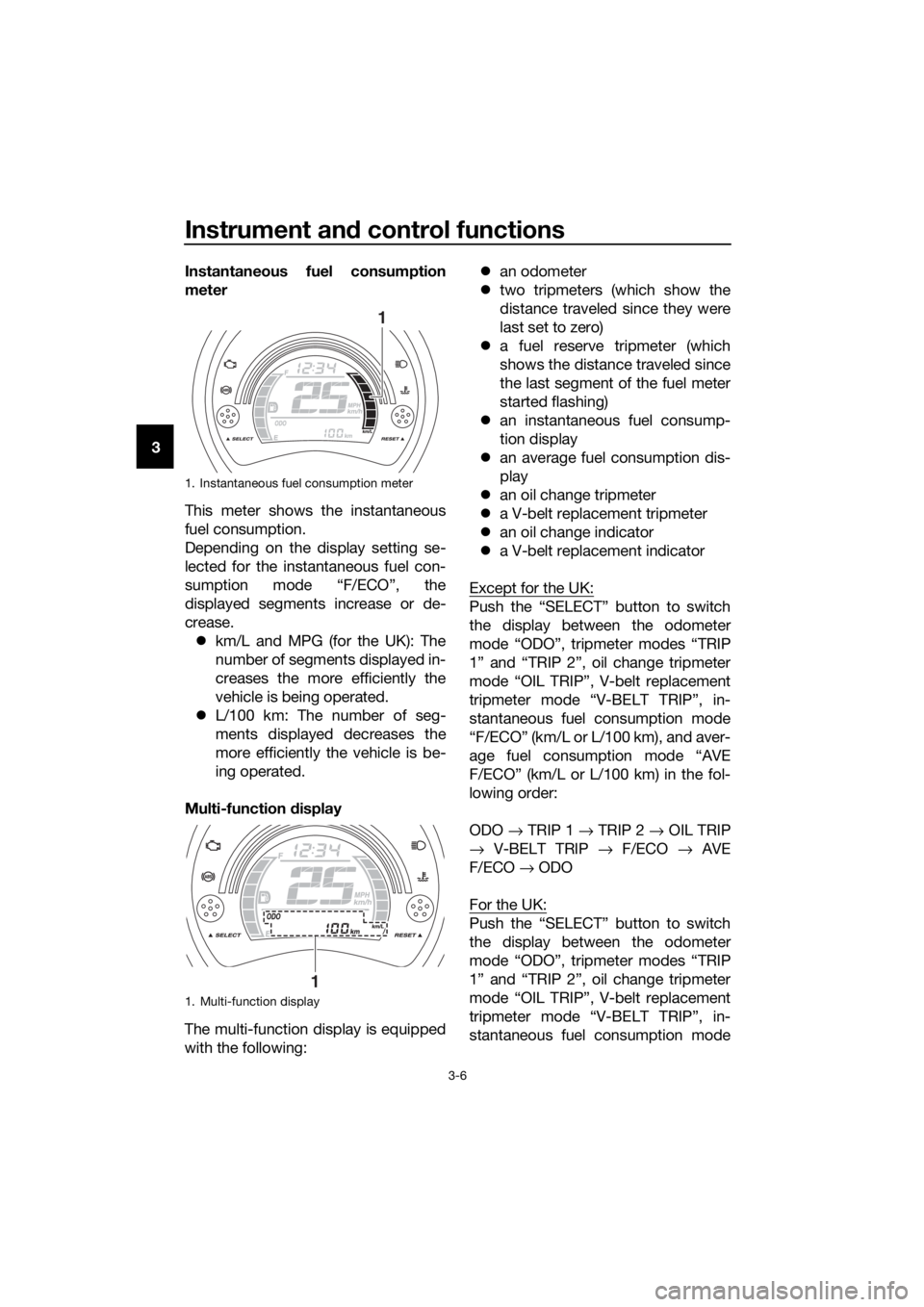
Instrument and control functions
3-6
3 Instantaneous fuel consumption
meter
This meter shows the instantaneous
fuel consumption.
Depending on the display setting se-
lected for the instantaneous fuel con-
sumption mode “F/ECO”, the
displayed segments increase or de-
crease.
km/L and MPG (for the UK): The
number of segments displayed in-
creases the more efficiently the
vehicle is being operated.
L/100 km: The number of seg-
ments displayed decreases the
more efficiently the vehicle is be-
ing operated.
Multi-function display
The multi-function display is equipped
with the following:
an odometer
two tripmeters (which show the
distance traveled since they were
last set to zero)
a fuel reserve tripmeter (which
shows the distance traveled since
the last segment of the fuel meter
started flashing)
an instantaneous fuel consump-
tion display
an average fuel consumption dis-
play
an oil change tripmeter
a V-belt replacement tripmeter
an oil change indicator
a V-belt replacement indicator
Except for the UK:
Push the “SELECT” button to switch
the display between the odometer
mode “ODO”, tripmeter modes “TRIP
1” and “TRIP 2”, oil change tripmeter
mode “OIL TRIP”, V-belt replacement
tripmeter mode “V-BELT TRIP”, in-
stantaneous fuel consumption mode
“F/ECO” (km/L or L/100 km), and aver-
age fuel consumption mode “AVE
F/ECO” (km/L or L/100 km) in the fol-
lowing order:
ODO → TRIP 1 → TRIP 2 → OIL TRIP
→ V-BELT TRIP → F/ECO → AVE
F/ECO → ODO
For the UK:
Push the “SELECT” button to switch
the display between the odometer
mode “ODO”, tripmeter modes “TRIP
1” and “TRIP 2”, oil change tripmeter
mode “OIL TRIP”, V-belt replacement
tripmeter mode “V-BELT TRIP”, in-
stantaneous fuel consumption mode
1. Instantaneous fuel consumption meter
1. Multi-function display
1
1
UBV3E0E0.book Page 6 Monday, September 26, 2016 3:42 PM